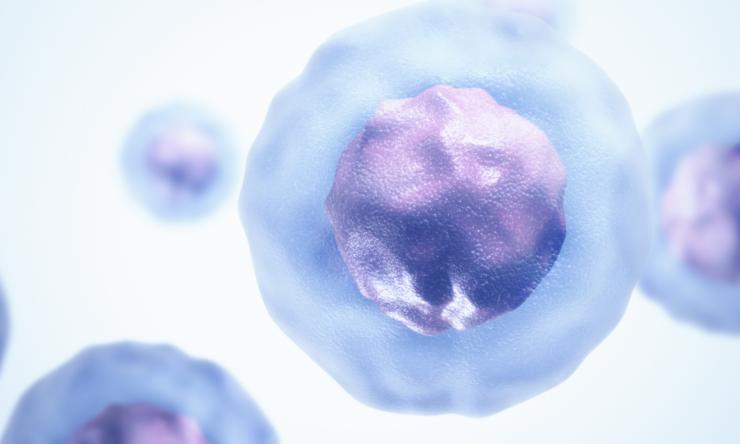hnRNPM, a guardian of the integrity of cellular protein production
Researchers at Baylor College of Medicine and collaborating institutions have discovered that a protein called hnRNPM helps protect the integrity of the process cells use to make proteins. The protein works by preventing the cell from making mistakes while it is putting together the different components, leading to newly produced proteins. In cancer cells, loss of hnRNPM triggers an interferon immune response, suggesting that this protein may hold clinical promise. The findings appeared in Molecular Cell.
“Synthesizing a protein is like putting together the different parts of a machine. If during the assembly process, parts that do not belong are incorporated into the machine, the final product would not fulfill its intended function, disturbing the normal workings of the cell and potentially leading to disease,” said co-corresponding author Dr. Chonghui Cheng, professor of the Lester and Sue Smith Breast Center, molecular and human genetics and molecular and cellular biology at Baylor. “Despite the many opportunities for such mistakes, cells make proteins highly accurately and precisely. Here we investigated what helps cells maintain the integrity of this vital process.”
When a cell needs to synthesize a protein, it begins by getting the instructions from the corresponding gene in the DNA. Imagine a necklace with beads separated by empty pieces of the string that threads them together as an analogy for the DNA molecule carrying the instructions to make a protein. The beads represent the exons, the segments of a DNA molecule containing the information coding for the protein of interest. The string between beads represents introns, DNA segments separating the exons. Introns do not code for the protein itself, they help guide the process that regulates gene expression.
To make a functional protein, the cell first transcribes the DNA information contained in exons and introns into a pre-mRNA molecule. Continuing with the analogy, the cell makes a pre-mRNA necklace with beads (exons) interspaced with string (introns). Next, from the pre-mRNA necklace the cell makes an mRNA necklace by splicing together the beads leaving out the string (introns) in between. This mRNA is finally translated into a functional protein.
The researchers investigated how cells prevented errors that could occur during the step in which exons are spliced together, which could lead to abnormal mRNA molecules. They examined splice sites, the segments that mark the location for the splicing of exons.
Pseudo splice sites and cryptic splicing
“The human genome has introns that are significantly longer than exons. These long introns contain numerous small segments, called pseudo splice sites, that are highly similar to the known correct splice sites,” said Cheng, a member of Baylor’s Dan L Duncan Comprehensive Cancer Center. “If pseudo splice sites are used instead of the correct splice sites during protein synthesis, the resulting mRNA will contain the wrong instructions – cryptic splicing – that could alter normal cell function.”
The researchers discovered that despite the presence of many pseudo splice sites, RNA splicing occurs accurately and precisely thanks to the RNA-binding protein hnRNPM. They discovered this by developing a bioinformatic pipeline that nominates cryptic sequences from datasets of RNA sequences.
“We found that hnRNPM preferentially binds to introns at regions containing pseudo splice sites,” said first author Dr. Rong Zheng, a graduate student in the Cheng lab while she was working on this project. “Their binding prevents or blocks the use of these splice sites when synthesizing RNA molecules, preventing cryptic splicing and therefore maintaining the integrity of the process.”
The team also discovered that in the absence of hnRNPM, cryptic splicing can form double stranded RNA (dsRNA), which is known to trigger interferon immune responses. “Tumors with low hnRNPM show increased cryptic splicing, interferon immune responses and immune infiltration,” Cheng said. “This finding suggests that inhibiting hnRNPM or enhancing the splicing of dsRNA-forming cryptic exons could represent innovative methods to activate immunity in patients with cancer.”
Other contributors to this work include Mikayla Dunlap, Georg O.M. Bobkov, Carlos Gonzalez-Figueroa, Khushali J. Patel, Jingyi Lyu, Samuel E. Harvey, Tracey W. Chan, Giovanni Quinones-Valdez, Mudra Choudhury, Charlotte A. Le Roux, Mason D. Bartels, Amy Vuong, Ryan A. Flynn, Howard Y. Chang, Eric L Van Nostrand and co-corresponding author Xinshu Xiao. The authors are affiliated with one of the following institutions: Baylor College of Medicine, University of California – Los Angeles or Stanford University School of Medicine.
This research was supported in part by grants from NIH (R35-CA209919, R01CA262686, R01AG078950 and R35GM131876) and cancer research scholarships from the Cancer Prevention Research Institute of Texas Scholars (RR200040 and RR160009).










